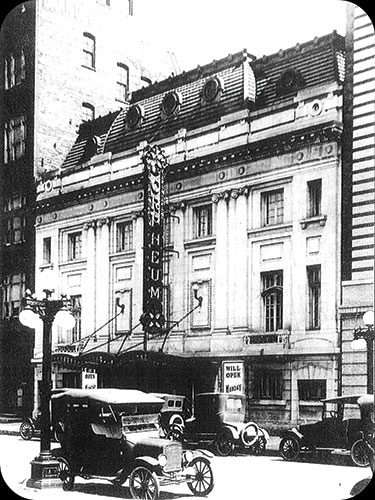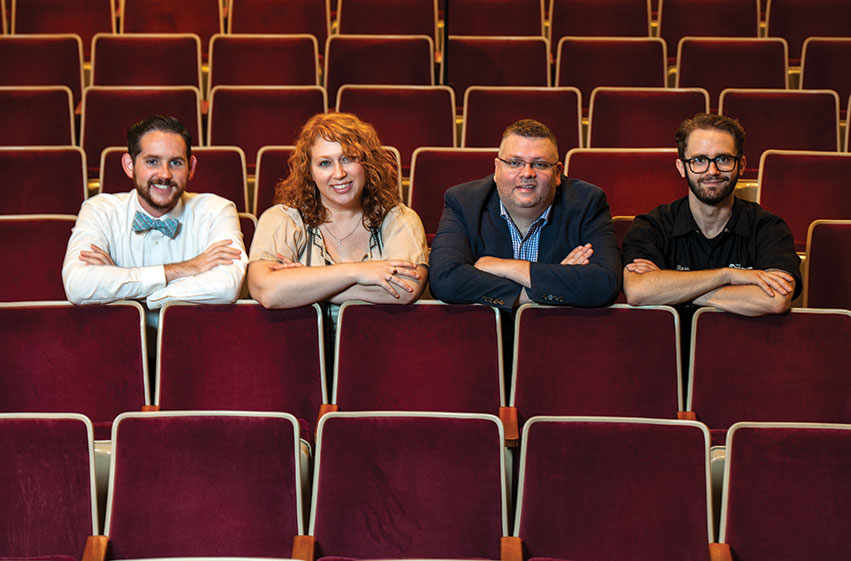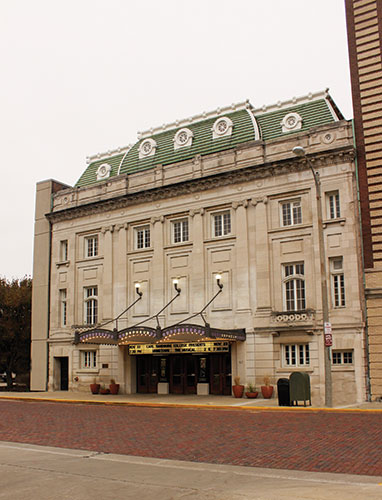Having stood the test of time, the historic Orpheum Theatre is the crown jewel of Galesburg.
The year was 1916. Woodrow Wilson was president, the Chicago Cubs played their first game at what would soon be known as Wrigley Field, and The Saturday Evening Post featured its first cover by a 22-year-old Norman Rockwell. In Europe, the trenches were full of troops and World War I was raging—though the United States would not join the fight for another year.
On Monday, August 21st, newspaper headlines proclaimed President Wilson’s attempts to avoid a nationwide railroad strike through arbitration. Allied forces had invaded Bulgaria, and a British newspaper was questioning the Americans’ neutral stance on the war. But in Galesburg, Illinois, all eyes were focused on a formidable building that was about to open its doors for the first time.
 Riding the Orpheum Circuit
Riding the Orpheum Circuit
It was part of the Orpheum Circuit, a turn-of-the-century national chain of vaudeville theaters, and later, movie houses. In 1886, the first Orpheum Opera House opened in San Francisco with the capacity to seat 3,500 people, and the popular operation soon expanded to Los Angeles, Kansas City, Omaha, Denver, Chicago and beyond.
Galesburg was a railroad town—an ideal location for an Orpheum. “Acts would pull a steamer trunk filled with costumes out of a train, go to a town, get off, perform… and back the trunk went on the train,” explains Kevin Maynard, executive director of the Orpheum Theatre in Galesburg.
Chicago architecture firm Rapp & Rapp designed many of the Orpheum theaters around the country, and was commissioned to design Galesburg’s as well. “By this point, they had mastered the process,” Maynard notes. “Theaters even larger than ours were being pumped out and opened up in less than nine months, which is incredible.”
On August 21, 1916, the Orpheum Theatre opened its doors to the Galesburg community. With its blend of European architectural styles both modern and classical, it was an elegant and breathtaking sight. Though two other theaters in town were already on the vaudeville circuit, the Orpheum was the “Cadillac” of theaters at the time, says Maynard. “It was the top of the line of the vaudeville era.”
Tickets on the main floor cost a quarter, balcony seats were a dime, and for those who could afford them, mezzanine box seats were 35 cents—which included greetings from an usher in white gloves, who would pour glasses of ice-cold water in the summer months. “It was to be a veritable house of enchantment, where the rich could rub elbows with the poor,” Maynard explains.
Between its three theaters, Galesburg hosted the biggest names in vaudeville—from singer Al Jolson and magician Harry Houdini to the Marx Brothers, who received their stage names one evening while touring Galesburg. “Performers went from theater to theater and moved on down the line. They typically did two shows a day,” Maynard explains. “When these theaters were built, you didn’t have movies or the internet. This is where people came.”
With the rise of the film industry, theaters across the country began to show motion pictures—and Galesburg’s Orpheum Theatre was no exception. “We found a filmstrip that we were able to date back to 1921,” says Maynard. “We know that as early as 1921 we were showing sound films.”
In the 1930s, the Orpheum was outfitted with air conditioning and a state-of-the-art sound system. Seven mezzanine boxes were removed to create a full balcony, and the theater played its first “talkie” in 1934. From that point forward, the Orpheum shifted from hosting live performers to become a dedicated movie house.
Decline and Rebirth
Over time, like other movie houses across the nation, the Orpheum’s clientele began to migrate to less grandiose cinema chains. By 1982, operating costs forced the theater—now owned by the Kerasotes chain—to close its doors.
The final movie to play at Galesburg’s Orpheum was a psychological thriller called The Sender, but because management had already sent some of their marquee letters to other theaters, they realized at the last minute they no longer had an “S.” As a result, the marquee read The Zender. “They popped all the popcorn they had left in anticipation of the crowds… and two people showed up,” Maynard says, shaking his head. “They had more staff than people for the final movie.”
The Orpheum Theatre remained closed for six years. As the building fell into disrepair, its owners were looking for any way to get rid of it—and even considered demolition. Eventually, Kerasotes sold the once-glorious structure for one dollar to the Knox County Civic Center Authority, and Prairie Players Civic Theatre was tapped to provide managerial oversight.
To generate interest in reviving the building, they began to throw “dirt parties.” “Basically, they had a generator and some lights, and there were little acts going on around the theater,” Maynard explains. “It was a way to get people to come in and experience the building. And it got people talking about it again.”
Following a successful fund drive—and with the help of a $2.5 million grant from the State of Illinois—the Orpheum underwent major renovations that brought it back from the dead. In 1988, the theater opened its doors once again with a celebratory re-inauguration gala featuring the Henry Mancini Orchestra.
Throughout the 1990s and into the 21st century, the Orpheum was used for rentals and as a performance space. Its Red Carpet Series kicked off in 2008, which helped to create more consistent programming. But times were still tough. Within a few short years, the theater’s revival would be taken to new heights—as a twist of fate brought a new executive director to Galesburg.

The Orpheum Theatre’s small but mighty staff: Kevin Maynard, executive director; Erin Glasnovich, operations manager; Tim Holmes, box office manager; and Ross McIntire, technical director. Photo by Kent Kriegshauser Photography
A Remarkable Transformation
In 2012, Kevin Maynard was finishing up his MBA at Western Illinois University when his girlfriend (and now wife), Lily Blouin, was cast in a production of Into The Woods in Galesburg. Accompanying Blouin to her rehearsals at the Orpheum, he worked from the back of the theater on his laptop. “I remember looking around and having all of these ideas,” he recalls.
Although the building was being used, it had seen better days. “Paint was peeling off of the walls, and the plaster had holes in it.” Galesburg was still recovering from the closure of its Maytag plant, and funds were hard to come by. But Maynard, who also had a theater background, couldn’t get the Orpheum out of his mind—even musing about his ideas with its operations manager, Erin Glasnovich.
His dream wouldn’t have to wait long. Later that year, the Orpheum announced its search for a new executive director, and by the spring of 2013, Maynard had the job.
His business acumen proved indispensable in the new position. “They sent me home with the financials, and I was like, ‘Oh boy. This is not good.’” After conducting a basic financial analysis, he estimated that if nothing changed, they would lose $250,000 that year. “Then they handed me a stack of bills,” he laughs. “We owed a lot of people money. It was rough.”
Adding insult to injury, Maynard discovered the theater had been scheduled for a renovation that summer—but due to lack of funds, the project couldn’t move forward. “So nothing had been booked… three solid months of money not coming in,” he recalls. “And we had to find sponsors and sell program ads for the Red Carpet Series. You can imagine what it’s like to call somebody and say, ‘Hey! I know we owe you thousands of dollars. But would you like to buy an ad?’”
Maynard’s first year at the Orpheum ended with a loss of $75,000—significant, but a far cry from the $250,000 loss he had projected. The following year, he and his team hit the ground running. “We [only] lost $488 that year,” he says with a smile, adding that a check for $500 arrived in the mail on the third of January. “If only it had arrived a few days earlier!”
The Orpheum ended 2015 in the black—a remarkable reversal of fortune. At the same time, the number of events taking place at the theater quadrupled from 2013 to 2016. None of this would have been possible, Maynard stresses, without the hard work and wisdom of his small but mighty staff: Erin Glasnovich (operations manager), Ross McIntire (technical director) and Tim Holmes (box office manager).
The theater also relies on its volunteers, including a man who showed up one day and offered his help restoring the building. A year into his tenure, Maynard decided to take Gary Morgan up on the offer. “He wanted to know if he could start that same day!” he says incredulously. For months on end, Morgan contributed 30 or more hours a week, repainting and repairing the plaster, and he still comes in a couple days a week. “He said he would be here for a year… and that was in 2014. He’s now like a member of the staff.”
Galesburg’s Crown Jewel
In 2016, the Orpheum Theatre set up a capital campaign to raise $850,000. “We surpassed our goal in the first three months,” Maynard says. By the end of the year, they had received $950,000. “We put all of it back into our building. As much of that money as possible stayed local—so it not only helped us, it gave our local businesses a shot in the arm.”
Throwback Thursday is one of the theater’s most popular series, inviting residents to watch films at no cost—which Maynard sees as the perfect way to give back to the community that has offered them so much support. “It’s a yearly tradition in Galesburg now,” he says. “It got people excited about the theater… and it helps feed everything else that we do here.”
That includes an eclectic lineup of all types of live entertainment, harkening back to its vaudeville roots. “We work very hard to create a well-rounded year,” he explains. “We bring in music, comedy, magic—a little bit of everything.”
As so many communities struggle with the upkeep of aging architecture, Galesburg’s Orpheum has managed to withstand more than a century of both use and neglect, major cultural shifts, and seemingly insurmountable financial ruin. Maynard’s unique balance of the creative arts and financial savvy is due much of the credit. “A lot of art entities have the mindset that the money will always come,” he notes. “But you have to make fiscally-minded decisions that creative types aren’t always able to do.”
These days, the Orpheum isn’t competing against movie theaters so much as the internet. “In our society, live entertainment is no different than pulling up a video on YouTube,” Maynard says. “A lot of people know that it’s not the same, but to some that doesn’t matter.” The internet may offer instant gratification, he adds, but it’s nothing like the intimacy revealed in a live performance.
As he discusses the theater’s incredible transformation over the years, Maynard proudly points to the original wrought-iron seats that have cradled its patrons for over a century. “The building itself—the architecture and the themes—are original to 1916. The patterns and the colors have changed over the years… but overall it has remained pretty much intact.”
While the acts may be different and the world has changed dramatically around it, the crown jewel of Galesburg is alive and well, 102 years after its opening. a&s
Visit galesburgorpheum.org for more information and a list of upcoming events. Visit peoriamagazines.com/PS for more stories related to the Orpheum Theatre in Galesburg (and in Peoria)—including how the Marx Brothers got their names, the Kennedy/Orpheum connection, and how one Hollywood star pushed the theatre to tear down the walls of racial segregation.


